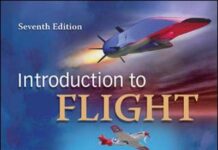
Ebook Info
- Published: 1995
- Number of pages: 574 pages
- Format: PDF
- File Size: 6.70 MB
- Authors: John Anderson
Description
This pioneering text provides an excellent introduction to CFD at the senior level in aerospace and mechanical engineering, and to some extent, chemical and civil engineering. It can also serve as a one-semester introductory course at the beginning graduate level, as a useful precursor to a more serious study of CFD in advanced books. It is presented in a very readable, informal, enjoyable style.
User’s Reviews
Editorial Reviews: About the Author John D. Anderson, Jr., was born in Lancaster, Pennsylvania, on October 1, 1937. He attended the University of Florida, graduating in 1959 with high honors and a Bachelor of Aeronautical Engineering Degree. From 1959 to 1962, he was a Lieutenant and Task Scientist at the Aerospace Research Laboratory at Wright-Patterson Air Force Base. From 1962 to 1966, he attended the Ohio State University under the National Science Foundation and NASA Fellowships, graduating with a PhD in Aeronautical and Astronautical Engineering. In 1966, he joined the U.S. Naval Ordnance Laboratory as Chief of the Hypersonics Group. In 1973, he became Chairman of the Department of Aerospace Engineering at the University of Maryland, and since 1980 has been Professor of Aerospace Engineering at the University of Maryland. In 1982, he was designated a Distinguished Scholar/Teacher by the University. During 1986–1987, while on sabbatical from the University, Dr. Anderson occupied the Charles Lindbergh Chair at the National Air and Space Museum of the Smithsonian Institution. He continued with the Air and Space Museum one day each week as their Special Assistant for Aerodynamics, doing research and writing on the History of Aerodynamics. In addition to his position as Professor of Aerospace Engineering, in 1993, he was made a full faculty member of the Committee for the History and Philosophy of Science and in 1996 an affiliate member of the History Department at the University of Maryland. In 1996, he became the Glenn L. Martin Distinguished Professor for Education in Aerospace Engineering. In 1999, he retired from the University of Maryland and was appointed Professor Emeritus. He is currently the Curator for Aerodynamics at the National Air and Space Museum, Smithsonian Institution.
Reviews from Amazon users which were colected at the time this book was published on the website:
⭐I am presently in my 4th year of a PhD in Astrophysics. While my background in the analytic portion of Fluid Dynamics is strong my understanding of how one discretizes and solves these equations numerically is somewhat lacking.I picked this book up as a starting point to more complicated methods and found it to be, hands down, one of the best texts I have ever read. It presents the material in a concise, clear, and physically motivated fashion which makes learning the topic incredibly straightforward.While this book is only a ‘kicking off’ point for more advanced techniques I think it is a must read for beginners and intermediate users. For the first timer to CFD the book will get you started down the right path armed with all the preliminary tools. For the more advanced user it will put aspects of the topic into an easier to understand light and perhaps shed more light on fundamentals that were presented poorly elsewhere.I’d give it ten stars, it’s allowed me to crack into the code I’m using and really understand why it works as well as having set me down the path to a more advanced level of understanding of CFD.
⭐This book is great for teaching yourself CFD as a beginner! Dr. Anderson does a wonderful job going through the finite difference method and it feels as if he’s speaking directly to you as the reader. If you’re interested in learning about CFD, this book is a must have.
⭐This is an excellent text to introduce students to CFD. The writing is very clear and enjoyable. The only complaints I have are (1) too many typos for a text published in 1995 (where is the corrected printing?) and (2) the applications and examples are almost exclusively aerodynamic. This is still the best place to begin an exploration of CFD.
⭐I found the basic knowledge for understanding the computational fluid dynamics. If you have “computational fluid dynamics, Hypersonic and high temperature of gas dynamic” and a software for solve linear system and EDO( like Mathenatica), you could make computational fluid dynamic.Also clarify “Time-dependent approach to the steady state”,”classification of quasi-linear partial differential equations”,”Implicit and Explicit methods”,”Boundary-fitted coordinate”,”Time and space marching”.
⭐Anderson talks TO you. Whereas in other fluids texts, the author basically just talks to himself; which isn’t nearly as personal or fruitful of a learning experience in my opinion. 5 stars.
⭐This is a very easy book to read. Anderson not only explains the computational methods, he covers the basics and explains the relevance of the equations and terms. This book addresses the needs for people with little background on this subject. I recommend it for any novice interested in obtaining a basic introduction to CFD.
⭐Most useful CFD text book I’ve ever read!
⭐this book deserves maximum 3 starts not more than that. it is an old book, pictures are back-white and not readable and some chapters (for example, chapter 3) is a summary of summaries. Trust what I said.
⭐Written in an easy way, yet very useful, for a person with somewhat rusty knowledge of the field.
⭐Like advertised. On time.
Keywords
Free Download Computational Fluid Dynamics 1st Edition in PDF format
Computational Fluid Dynamics 1st Edition PDF Free Download
Download Computational Fluid Dynamics 1st Edition 1995 PDF Free
Computational Fluid Dynamics 1st Edition 1995 PDF Free Download
Download Computational Fluid Dynamics 1st Edition PDF
Free Download Ebook Computational Fluid Dynamics 1st Edition
